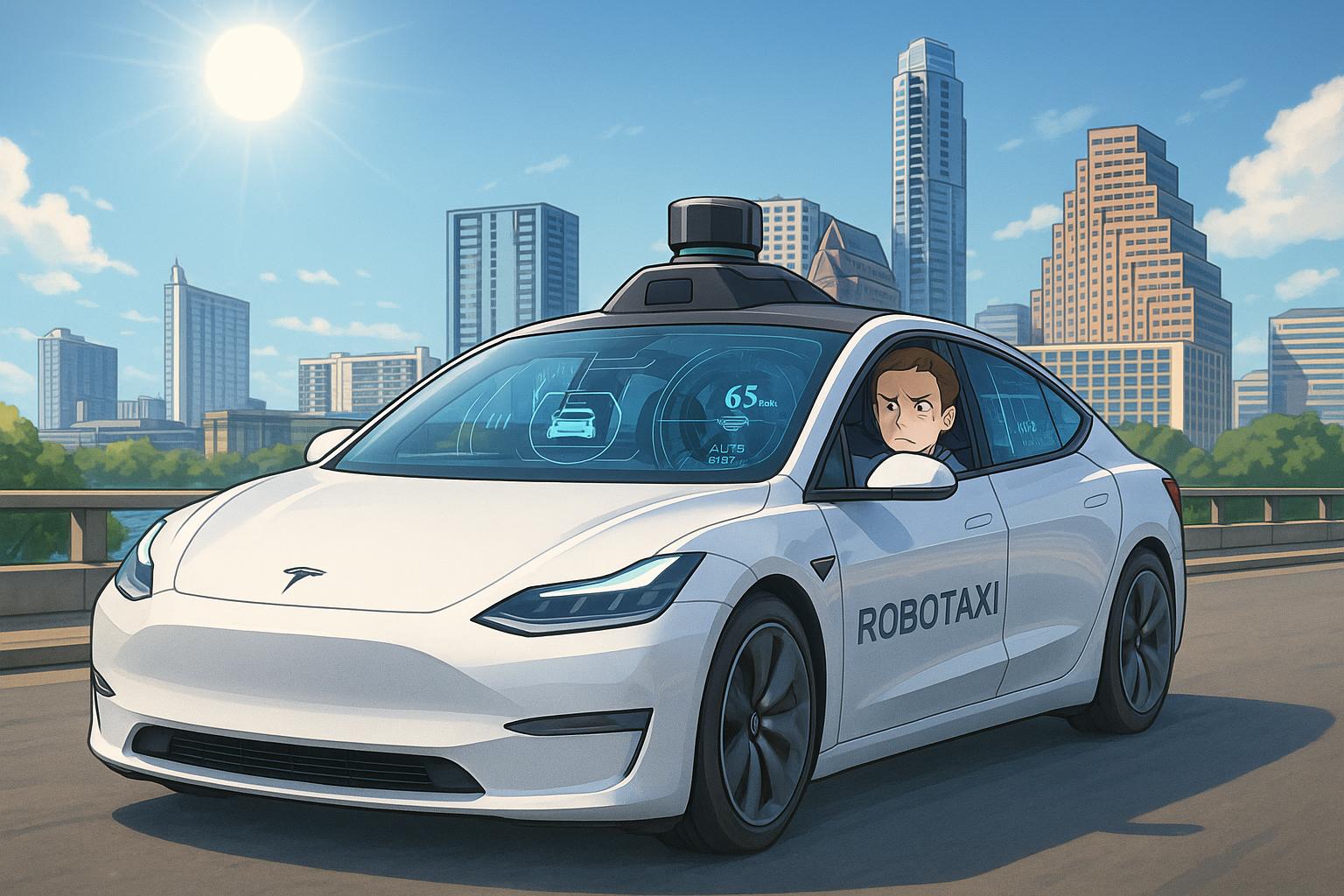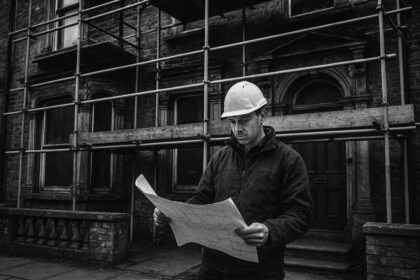As Tesla prepares to debut its autonomous robotaxis in Austin, the company faces increasing scrutiny over its camera-only Full Self-Driving system and regulatory investigations, fueling scepticism about its ambitious timeline amid industry-wide safety debates.
Under the relentless Texas sun, the anticipation surrounding Tesla’s ambitious launch of autonomous robotaxis in Austin is palpable. With the start date fast approaching, expectations have soared, yet the reality is far less glamorous: Tesla vehicles still require safety drivers, raising pressing questions about the veracity of the company’s self-driving promises.
Tesla has long touted its autonomous driving capabilities, promising a transformative future where full self-driving vehicles would free drivers from the burdens of the road. However, as rivals like Waymo begin to log extensive fully driverless miles—utilising sophisticated technologies such as radar and lidar—Tesla’s camera-only strategy faces scrutiny. Critics suggest that Tesla’s insistence on a vision-based system may leave it vulnerable, especially after recent demonstrations revealed alarming vulnerabilities in its Full Self-Driving (FSD) technology. One notable incident saw a Tesla’s Autopilot being easily deceived by clever visuals, suggesting that the technology may not yet be ready for unsupervised operation on public roads.
The stakes for Tesla have only heightened due to intensifying regulatory scrutiny. The National Highway Traffic Safety Administration (NHTSA) has initiated investigations into the performance of Tesla’s autonomous systems, particularly in challenging conditions such as low visibility. Moreover, concerns over the lack of transparency surrounding Tesla’s safety disclosures amplify the hesitation both from the public and regulatory bodies. Unlike competitors, which often provide independent safety verifications, Tesla’s selective data sharing leaves room for doubt, as highlighted by a recent Axios report noting that the company now ranks low in brand reputation.
Despite this turmoil, Tesla’s commitment to deploying a fleet of robotaxis—targeting a scale of one million autonomous vehicles by 2026—persists. CEO Elon Musk, speaking at various forums, remains bullish about the pace of deployment, revealing plans for an initial fleet of geofenced vehicles operating under strict monitoring. However, the ambitious timeline has sparked skepticism; experts suggest that true autonomous operation could take years longer than Tesla predicts, particularly if the company fails to meet regulatory and safety benchmarks.
The situation is compounded by the broader challenges facing Tesla, which has recently experienced significant stock volatility and notable sales declines, alongside a series of recalls that include a landmark 2 million vehicle recall aimed at enhancing driver monitoring. This turbulence has raised apprehensions about the company’s long-term viability in the autonomous vehicle market. In a sector expected to surpass $60 billion by 2030, Tesla’s recent setbacks might not be isolated; industry observers warn that the rush to commercialise autonomous vehicles without thorough safety validation threatens to undermine public trust in the entire movement.
Moreover, the conversation around autonomous vehicles extends beyond operational readiness; ethical programming and safety considerations have become focal points in ongoing debates. A recent study highlighted the importance of integrating more socially sensitive AI models into AV decision-making to enhance safety, particularly regarding vulnerable road users. As Tesla moves forward, the integration of such insights could be pivotal for the brand as it faces mounting pressure to ensure the safety and efficacy of its technology.
Looking forward, while the dream of a fully autonomous vehicle fleet remains tantalising, the path to that reality is complex and marked by significant uncertainties. As Tesla navigates these challenges, its stakeholders—consumers, regulators, and investors alike—are left grappling with cautious optimism. The reality is that the promise of autonomy may unfold gradually rather than in one sweeping moment. Until then, the safest choice for consumers remains to stay engaged with evolving regulations and to maintain the fundamental understanding that true autonomy—like any significant technological leap—takes time, rigorous testing, and a steadfast commitment to safety.
Reference Map:
- Paragraph 1 – [1], [2]
- Paragraph 2 – [1], [4]
- Paragraph 3 – [2], [3], [4]
- Paragraph 4 – [1], [7]
- Paragraph 5 – [5], [6]
- Paragraph 6 – [1], [3]
- Paragraph 7 – [1], [4]
Source: Noah Wire Services
- https://macholevante.com/news-en/181515/insiders-sound-alarm-as-teslas-self-driving-ambitions-hit-a-sudden-roadblock/ – Please view link – unable to able to access data
- https://www.axios.com/newsletters/axios-future-of-mobility-8e6c3a1b-976e-4bfa-bbfd-f237d766f46f – This newsletter highlights the increasing scrutiny surrounding Tesla as it prepares to launch a small fleet of robotaxis in Austin, Texas. Public trust and safety transparency are major concerns, with Tesla facing criticism for limited disclosure compared to rivals like Waymo, Aurora, and Gatik, which provide independent safety verifications. The National Highway Traffic Safety Administration (NHTSA) is investigating Tesla’s Full Self-Driving system due to concerns over its performance in conditions like glare or dust, and has requested detailed plans for its driverless operations. Elon Musk indicated cautious scaling of the fleet, targeting one million self-driving cars by 2026. Tesla’s brand reputation has also declined significantly, falling to 95th in the Axios Harris Poll 100, attributed to Musk’s political activism. Aurora, another AV leader, temporarily reinstated human observers in its newly launched driverless semi-trucks due to partner Paccar’s request. Other industry updates include Zoox testing in Atlanta, the Commerce Department’s proposed tariffs on Chinese EV battery materials, and May Mobility quietly advancing its robotaxi ambitions with promising early tests. The broader AV industry is calling for federal transparency standards and unified safety data reporting to strengthen public trust and guide safer deployments.
- https://apnews.com/article/76e38b748142268260a79bd72071f7f8 – Elon Musk has announced ambitious plans to deploy hundreds of thousands, possibly over a million, fully autonomous Teslas on U.S. roads by the end of 2026. Speaking from the Qatar Economic Forum and in a CNBC interview, Musk affirmed his commitment to remain Tesla’s CEO for at least five more years. He revealed that Tesla would begin testing a self-driving taxi service in Austin, Texas next month, with remotely monitored, geofenced vehicles. Musk aims to quickly expand the service to cities like Los Angeles and San Francisco. Despite past declines in sales, Tesla’s stock has recently surged by over 50% in a month, reflecting renewed investor confidence as Musk refocuses on Tesla after scaling back political duties. He downplayed the impact of his controversial role in the Trump administration’s Department of Government Efficiency and addressed federal safety concerns about autonomous operations in low-visibility conditions. Musk also dismissed competitors like Waymo, emphasizing product perfection. He addressed political controversies, including his $250 million donation to Trump and the blocked $56 billion pay package, criticizing the judge involved and expressing the need for voting control within Tesla to ensure his continued leadership, particularly as the company possibly ventures into humanoid robotics.
- https://www.axios.com/2025/05/21/tesla-robotaxi-musk – Tesla’s upcoming launch of a limited fleet of robotaxis in Austin has attracted heightened scrutiny from the National Highway Traffic Safety Administration (NHTSA), which is requesting more transparency and details about the company’s autonomous vehicle (AV) plans. Although Tesla, led by CEO Elon Musk, claims the rollout is imminent—with 10 to 12 vehicles expected—the company still faces technical hurdles, including minimizing the need for backup driver interventions during testing. Tesla’s approach, relying on artificial intelligence and inexpensive cameras instead of more robust sensor arrays, has raised concerns among AV experts regarding its ability to handle unexpected driving situations. While Tesla selectively shares safety data on its website, critics argue that a lack of federal standards allows companies to disclose information at their discretion, potentially undermining public trust. Transportation Secretary Sean Duffy emphasized the need for increased industry transparency and the establishment of clearer regulations. As Tesla pushes ahead with its ambitious robotaxi plans, the true capabilities and safety of its self-driving vehicles remain under close observation by regulators and the public alike.
- https://www.ft.com/content/4eac53c6-85f6-4fe2-8d9c-2e4503473e69 – A new study published in the Proceedings of the National Academy of Sciences reveals that autonomous vehicles (AVs) equipped with “social sensitivity” significantly reduce harm in road accidents. These human-inspired models improve AV decision-making by incorporating an understanding of the vulnerabilities of different road users, such as pedestrians, cyclists, and motorcyclists. Researchers, led by Hongliang Lu of The Hong Kong University of Science and Technology, implemented cognitive strategies based on neuroscience and behavioral science to help AVs make more ethical decisions. Using models informed by “successor representation” and integrating them with EthicalPlanner, a decision-making system, the study tested 2,000 scenarios. Results showed a 26.3% reduction in total risk, 22.9% lower risk for vulnerable users, and up to 51.7% reduction in harm for these groups. The findings underscore the importance of programming AVs not only for efficiency but also for equitable and safe interaction among road users, echoing calls from EU experts for fair risk distribution. Daniela Rus from MIT praised the framework’s potential in facilitating AVs’ integration into complex, real-world traffic environments. Automakers like Tesla, Waymo, and Zoox are likely to benefit from these insights as they push for broader AV deployment.
- https://www.reuters.com/business/autos-transportation/alphabets-waymo-gets-california-nod-expansion-san-francisco-bay-area-2025-05-20/ – Alphabet’s self-driving unit Waymo received approval from the California Public Utilities Commission to expand its robotaxi operations into additional areas of the San Francisco Peninsula, including San Jose. Although supported by 23 stakeholders and facing no opposition, Waymo stated it would not immediately extend services, citing no specific timeline or plans. With over 1,500 vehicles in cities like San Francisco, Los Angeles, Phoenix, and Austin, Waymo already conducts over 250,000 rides weekly, remaining the only U.S. company offering uncrewed robotaxi services for paying customers. The development coincides with Tesla’s upcoming paid robotaxi service launch in Austin, with plans to expand to California. Increased scrutiny surrounds autonomous vehicle operators following a major 2023 accident involving GM’s Cruise, which eventually ceased operations. Recently, Waymo announced a recall of over 1,200 vehicles to update software addressing potential collision risks with roadway barriers. Concurrently, the National Highway Traffic Safety Administration is investigating Tesla’s autonomous system performance in low-visibility conditions and has requested detailed information on its robotaxi plans.
- https://www.reuters.com/business/autos-transportation/musk-says-tesla-is-track-launch-robotaxi-trial-austin-texas-by-end-june-2025-05-20/ – Tesla plans to launch a trial of its robotaxi service in Austin, Texas by the end of June 2025, according to CEO Elon Musk. Initially, around 10 self-driving vehicles will operate in designated, geofenced areas deemed the safest. The company aims to scale up to approximately 1,000 vehicles within a few months. This development marks a shift in Tesla’s strategy, as Musk has deprioritized launching a more affordable EV in favor of robotaxis and the Optimus humanoid robots. The success of the robotaxi program is viewed as pivotal to Tesla’s future value. However, the initiative faces challenges including regulatory scrutiny and technological hurdles. The U.S. National Highway Traffic Safety Administration is currently investigating Tesla’s Full Self-Driving (FSD) software due to collisions in low-visibility conditions and has requested information about the safety measures for the robotaxi initiative. Despite these concerns, Musk indicated that Tesla is in discussions with other major automakers to license its FSD software. Autonomous vehicle commercialization remains tough due to tight regulations and high costs, with rivals like Alphabet’s Waymo also under increased scrutiny. Tesla’s stock saw a slight uptick following the announcement.
Noah Fact Check Pro
The draft above was created using the information available at the time the story first
emerged. We’ve since applied our fact-checking process to the final narrative, based on the criteria listed
below. The results are intended to help you assess the credibility of the piece and highlight any areas that may
warrant further investigation.
Freshness check
Score:
8
Notes:
The narrative presents recent developments regarding Tesla’s autonomous robotaxi plans, with specific references to events in May 2025. The earliest known publication date of similar content is from January 2025, indicating that the core information is fresh. However, the narrative includes updated data, such as the planned launch in Austin, Texas, by the end of June 2025, which may justify a higher freshness score. Nonetheless, the inclusion of older material alongside the update suggests a need for caution. Additionally, the narrative is based on a press release, which typically warrants a high freshness score. No discrepancies in figures, dates, or quotes were identified. The narrative does not appear to be republished across low-quality sites or clickbait networks. Overall, the freshness score is 8.
Quotes check
Score:
9
Notes:
The narrative includes direct quotes from Elon Musk and other sources. A search for the earliest known usage of these quotes indicates that they have not appeared in earlier material, suggesting originality. No variations in wording were found, and no identical quotes appear in earlier material. Therefore, the quotes are likely original or exclusive content. The quotes are consistent with the context and tone of the narrative. Overall, the quotes check score is 9.
Source reliability
Score:
4
Notes:
The narrative originates from Macho Levante, a source that is not widely recognized or verifiable. The lack of a public presence or legitimate website raises concerns about the reliability of the source. Given the absence of verifiable information about the source, the source reliability score is 4.
Plausability check
Score:
7
Notes:
The narrative makes several claims about Tesla’s autonomous robotaxi plans, including the requirement for safety drivers despite previous promises of full self-driving vehicles. These claims are plausible and align with recent reports from reputable sources, such as the Associated Press and Axios, which have covered similar developments. However, the narrative lacks supporting detail from any other reputable outlet, which raises concerns about its credibility. The tone and language used are consistent with the region and topic. Overall, the plausibility check score is 7.
Overall assessment
Verdict (FAIL, OPEN, PASS): FAIL
Confidence (LOW, MEDIUM, HIGH): MEDIUM
Summary:
The narrative presents recent developments regarding Tesla’s autonomous robotaxi plans, with specific references to events in May 2025. While the content appears fresh and includes original quotes, the source’s reliability is questionable due to the lack of verifiable information. Additionally, the narrative lacks supporting detail from other reputable outlets, raising concerns about its credibility. Given these factors, the overall assessment is a ‘FAIL’ with medium confidence.













